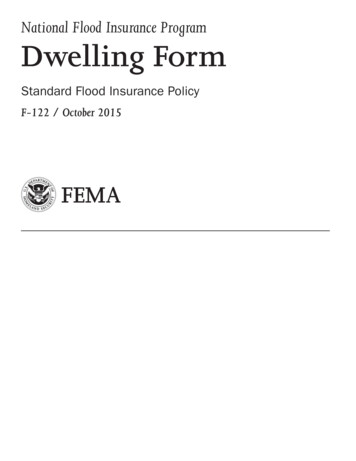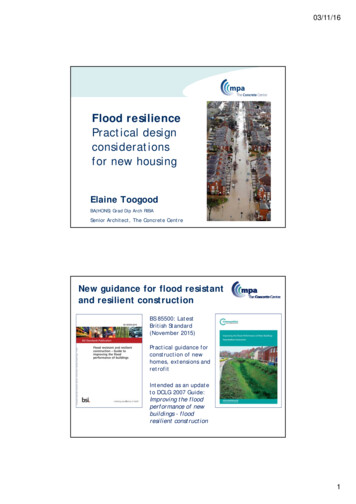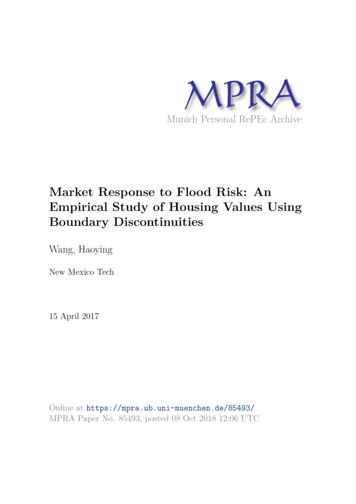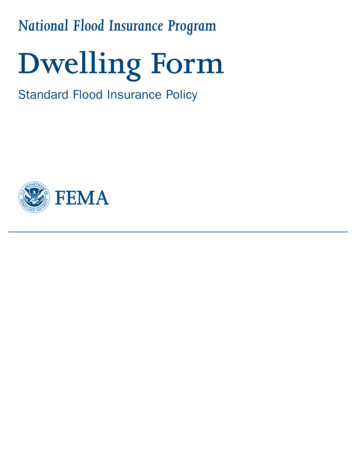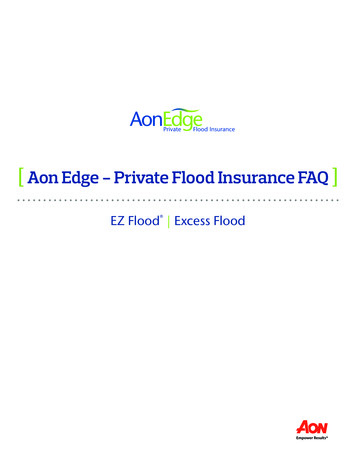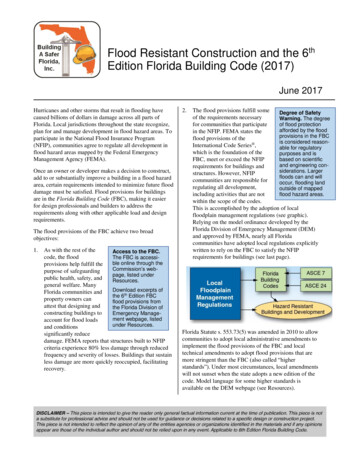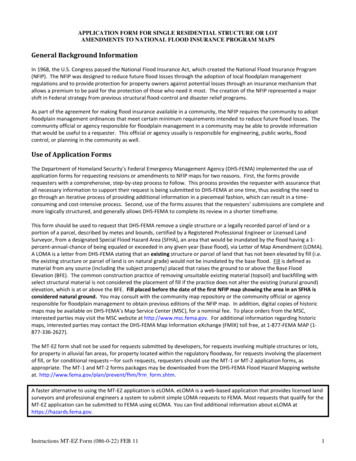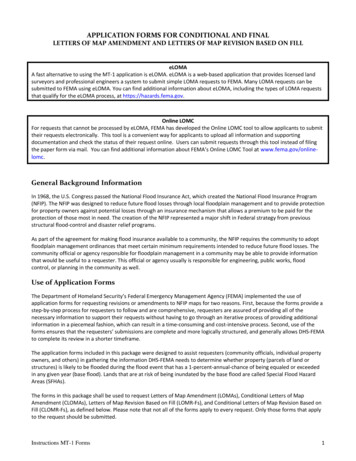
Transcription
Affordability of National Flood Insurance Program Premiums: Report 2AFFO RDABILIT Y O FNATIONAL FLOOD INSURANCEPROGRAM PREMIUMSR E P O RT2Committee on Affordability ofNational Flood Insurance Program PremiumsWater Science and Technology BoardDivision on Earth and Life StudiesBoard on Mathematical Sciences and Their ApplicationsDivision on Engineering and Physical SciencesCommittee on National StatisticsDivision on Behavioral and Social Sciences and EducationCopyright National Academy of Sciences. All rights reserved.
Affordability of National Flood Insurance Program Premiums: Report 2THE NATIONAL ACADEMIES PRESS500 Fifth Street, NWWashington, DC 20001This activity was supported by the Federal Emergency Management Agency Contract Number HSHQDC-11-D-0009/HSFE60-13-J-0025. Any opinions, findings,conclusions, or recommendations expressed in this publication do not necessarilyreflect the views of any organization or agency that provided support for the project.International Standard Book Number-13: 978-0-309-38077-5International Standard Book Number-10: 0-309-38077-4Additional copies of this report are available for sale from the National AcademiesPress, 500 Fifth Street NW, Keck 360, Washington, DC 20001; (800) 624-6242 or(202) 334-3313; http://www.nap.edu.Cover: Image courtesy of the U.S. Coast Guard.Copyright 2016 by the National Academy of Sciences. All rights reserved.Printed in the United States of America.Suggested citation: National Academies of Sciences, Engineering, and Medicine.2016. Affordability of National Flood Insurance Program Premiums—Report 2.Washington, DC: The National Academies Press.Copyright National Academy of Sciences. All rights reserved.
Affordability of National Flood Insurance Program Premiums: Report 2The National Academy of Sciences was established in 1863 by an Act of Congress, signed by President Lincoln, as a private, nongovernmental institutionto advise the nation on issues related to science and technology. Members areelected by their peers for outstanding contributions to research. Dr. Ralph J.Cicerone is president.The National Academy of Engineering was established in 1964 under the charter of the National Academy of Sciences to bring the practices of engineeringto advising the nation. Members are elected by their peers for extraordinarycontributions to engineering. Dr. C. D. Mote, Jr., is president.The National Academy of Medicine (formerly the Institute of Medicine) wasestab lished in 1970 under the charter of the National Academy of Sciences toadvise the nation on medical and health issues. Members are elected by theirpeers for distinguished contributions to medicine and health. Dr. Victor J. Dzauis president.The three Academies work together as the National Academies of Sciences,Engineering, and Medicine to provide independent, objective analysis and advice to the nation and conduct other activities to solve complex problemsand inform public policy decisions. The Academies also encourage education andresearch, recognize outstanding contributions to knowledge, and increase publicunderstanding in matters of science, engineering, and medicine.Learn more about the National Academies of Sciences, Engineering, and Medicine at www.national-academies.org.Copyright National Academy of Sciences. All rights reserved.
Affordability of National Flood Insurance Program Premiums: Report 2Copyright National Academy of Sciences. All rights reserved.
Affordability of National Flood Insurance Program Premiums: Report 2COMMITTEE ON AFFORDABILITY OFNATIONAL FLOOD INSURANCE PREMIUMSLEONARD A. SHABMAN, Chair, Resources for the Future, Washington,D.C.SUDIPTO BANERJEE, University of California, Los AngelesJOHN J. BOLAND, Johns Hopkins University, Baltimore, MarylandPATRICK L. BROCKETT, University of Texas, AustinRAYMOND J. BURBY, University of North Carolina, Chapel HillSCOTT EDELMAN, AECOM, Greensboro, North CarolinaW. MICHAEL HANEMANN, Arizona State University, TempeCAROLYN KOUSKY, Resources for the Future, Washington, D.C.HOWARD C. KUNREUTHER, University of Pennsylvania, PhiladelphiaSHIRLEY LASKA, University of New Orleans, New Orleans, LouisianaDAVID R. MAIDMENT, University of Texas, AustinDAVID MAURSTAD, OST, Inc., Washington, D.C.ALLEN L. SCHIRM, Mathematica Policy Research, Washington, D.C.StaffED J. DUNNE, Study Director, Water Science and Technology BoardCONSTANCE F. CITRO, Senior Board Director, Committee on NationalStatisticsSCOTT T. WEIDMAN, Director, Board on Mathematical Sciences andTheir ApplicationsANITA A. HALL, Senior Program Associate, Water Science andTechnology BoardvCopyright National Academy of Sciences. All rights reserved.
Affordability of National Flood Insurance Program Premiums: Report 2WATER SCIENCE AND TECHNOLOGY BOARDGEORGE M. HORNBERGER, Chair, Vanderbilt University, Nashville,TennesseeEDWARD J. BOUWER, Johns Hopkins University, Baltimore, MarylandDAVID A. DZOMBAK, Carnegie Mellon University, Pittsburgh,PennsylvaniaM. SIOBHAN FENNESSY, Kenyon College, Gambier, OhioBEN GRUMBLES, Maryland Department of the Environment, BaltimoreGEORGE R. HALLBERG, The Cadmus Group, Watertown, MassachusettsARTURO A. KELLER, University of California, Santa BarbaraCATHERINE L. KLING, Iowa State University, AmesLARRY LARSON, Association of State Floodplain Managers, Madison,WisconsinDINAH LOUDA, Veolia Institute, Paris, FranceDAVID I. MAURSTAD, OST, Inc., Washington, D.C.STEPHEN POLASKY, University of Minnesota, St. PaulMARYLYNN V. YATES, University of California, RiversideJAMES W. ZIGLAR, SR., Van Ness Feldman, Washington, D.C.StaffJEFFREY JACOBS, DirectorLAURA J. EHLERS, Senior Program OfficerSTEPHANIE E. JOHNSON, Senior Program OfficerED J. DUNNE, Program OfficerM. JEANNE AQUILINO, Financial and Administrative AssociateMICHAEL J. STOEVER, Research AssociateANITA A. HALL, Senior Program AssociateBRENDAN R. MCGOVERN, Senior Program AssistantviCopyright National Academy of Sciences. All rights reserved.
Affordability of National Flood Insurance Program Premiums: Report 2BOARD ON MATHEMATICAL SCIENCESAND THEIR APPLICATIONSDONALD G. SAARI, Chair, University of California, IrvineDOUGLAS N. ARNOLD, University of Minnesota, MinneapolisJOHN B. BELL, E.O. Lawrence Berkeley National Laboratory, Berkeley,CaliforniaVICKI M. BIER, University of Wisconsin, MadisonJOHN R. BIRGE, The University of Chicago, Chicago, IllinoisRONALD R. COIFMAN, Yale University, New Haven, ConnecticutL. ANTHONY COX, JR., Cox Associates, Denver, ColoradoMARK L. GREEN, University of California, Los AngelesPATRICIA A. JACOBS, Naval Postgraduate School, Monterey, CaliforniaBRYNA KRA, Northwestern University, Evanston, IllinoisJOSEPH A. LANGSAM, University of Maryland, College ParkSIMON A. LEVIN, Princeton University, Princeton, New JerseyANDREW W. LO, Massachusetts Institute of Technology, CambridgeDAVID MAIER, Portland State University, Portland, OregonWILLIAM A. MASSEY, Princeton University, Princeton, New JerseyJUAN C. MEZA, University of California, MercedFRED S. ROBERTS, Rutgers University, Piscataway, New JerseyGUILLERMO SAPIRO, Duke University, Durham, North CarolinaCARL P. SIMON, University of Michigan, Ann ArborKATEPALLI SREENIVASAN, New York University, New York, New YorkELIZABETH A. THOMPSON, University of Washington, SeattleStaffSCOTT T. WEIDMAN, DirectorNEAL D. GLASSMAN, Senior Program OfficerMICHELLE K. SCHWALBE, Program OfficerBETH DOLAN, Financial AssociateRODNEY HOWARD, Administrative AssistantviiCopyright National Academy of Sciences. All rights reserved.
Affordability of National Flood Insurance Program Premiums: Report 2COMMITTEE ON NATIONAL STATISTICSLAWRENCE D. BROWN, Chair, University of Pennsylvania, PhiladelphiaJOHN M. ABOWD, Cornell University, Ithaca, New YorkMICHAEL HOUT, New York University, New YorkKAREN KAFADAR, Indiana University, BloomingdaleSALLIE KELLER, Science and Technology Policy Institute, Washington, DCLISA LYNCH, Brandeis University, Waltham, MassachusettsSALLY C. MORTON, University of Pittsburgh, Pittsburgh, PennsylvaniaJOSEPH NEWHOUSE, Harvard University, Cambridge, MassachusettsSAMUEL H. PRESTON, University of Pennsylvania, PhiladelphiaHAL S. STERN, University of California, IrvineROGER TOURANGEAU, University of Maryland, College Park, andUniversity of Michigan, EmeritusALAN ZASLAVSKY, Harvard Medical School, Boston, MassachusettsStaffCONSTANCE F. CITRO, DirectorMICHAEL L. COHEN, Senior Program OfficerDANIEL L. CORK, Senior Program OfficerAGNES E. GASKIN, Administrative AssistantHERMANN HABERMANN, Senior Program OfficerBRIAN HARRIS-KOJETIN, Deputy DirectorCAROL C. HOUSE, Senior Program OfficerMARY KASPER, Senior Program AssistantNANCY J. KIRKENDALL, Senior Program OfficerJULIA KISA-SHAKEER, Financial AssociateEILEEN LEFURGY, Program CoordinatorCHRISTOPHER D. MACKIE, Senior Program OfficerANTHONY S. MANN, Program AssociateKRISZTINA MARTON, Senior Program OfficerGEORGE SCHOEFFEL, Research AssistantESHA SINHA, Associate Program OfficerMICHAEL J. SIRI, Program AssociateCYNTHIA THOMAS, Senior Program OfficerGLENN WHITE, Senior Program OfficerJORDYN WHITE, Program OfficerGOOLOO WUNDERLICH, Senior Program OfficerviiiCopyright National Academy of Sciences. All rights reserved.
Affordability of National Flood Insurance Program Premiums: Report 2AcknowledgmentsThe report was reviewed in draft form by individuals chosen for theirbreadth of perspectives and technical expertise in accordance withthe procedures approved by the National Academies’ Report ReviewCommittee. The purpose of this independent review was to provide candidand critical comments to assist the institution in ensuring that its publishedreport is scientifically credible and that it meets institutional standardsfor objectivity, evidence, and responsiveness to the study charge. The review comments and draft manuscript remain confidential to protect theintegrity of the deliberative process. We wish to thank the following indi viduals for their review of this report: Kenneth J. Arrow, National Academyof Sciences/National Academy of Medicine, Stanford University; BruceBender, Bender Consulting Services, Inc., Phoenix, AZ; Chad B erginnis,The Association of State Floodplain Managers, Madison, WI; LawrenceD. Brown, University of Pennsylvania, Philadelphia; Lloyd Dixon, RANDCorporation, Santa Monica, CA; Gerald Galloway, National Academy ofEngineering, University of Maryland, College Park; Earthea Nance, TexasSouthern University, Houston, TX; and Doug Plasencia, Michael Baker Jr.Inc., Phoenix, AZ.Although the reviewers listed above have provided many constructivecomments and suggestions, they were not asked to endorse the conclusionsor recommendations nor did they see the final draft of the report beforeits release. The review of this report was overseen by Michael Goodchild,University of California, Santa Barbara, and David Moreau, University ofNorth Carolina, Chapel Hill. Appointed by the National Research Council (NRC), they were responsible for making certain that an independentixCopyright National Academy of Sciences. All rights reserved.
Affordability of National Flood Insurance Program Premiums: Report 2xACKNOWLEDGMENTSexamination of this report was carried out in accordance with institutional procedures and that all review comments were carefully considered. Responsibility for the final content of this report rests entirely with theauthoring committee and the NRC.Copyright National Academy of Sciences. All rights reserved.
Affordability of National Flood Insurance Program Premiums: Report 2PrefaceThe National Flood Insurance Program (NFIP) was created by Congress in 1968 and over the years an uncounted number of studies andreports have reviewed the program’s structure and operations, oftenmaking recommendations for reform. Many, but not all, of these reportswere made at the request of Congress. The reports of this committee wereprepared in response to a congressional request in the Biggert-Waters FloodInsurance Reform Act of 2012 (BW 2012).BW 2012, Section 100236, mandated that the Federal Emergency Management Agency (FEMA) conduct a study in cooperation with the NationalAcademy of Sciences (NAS) that would “compare the costs of a program ofrisk-based rates and means-tested assistance to the current system of subsidized flood insurance rates and federally funded disaster relief for peoplewithout coverage.” This came to be known as the “affordability study” asa shorthand reference.In response, the Water Science and Technology Board in the Division on Earth and Life Studies at NAS, in collaboration with the Boardon Mathematical Sciences and their Applications, and the Committee onNational Statistics, convened the committee on Affordability of NationalFlood Insurance Program Premiums. The committee members for bothreports included persons who collectively brought expertise in insurance, economics, floodplain management, national flood and disaster science andpolicy, mapping and spatial statistics, and risk perception and communication to the work of the committee.To fulfill the mandate of BW 2012, FEMA and NAS agreed to a planof work to produce two reports. The first report, titled “Affordability ofxiCopyright National Academy of Sciences. All rights reserved.
Affordability of National Flood Insurance Program Premiums: Report 2xiiPREFACENational Flood Insurance Program Premiums—Report 1,” described policyoptions and decisions to be made for FEMA’s consideration as it formulates affordability policy alternatives for consideration by Congress. Thefirst report was publicly released for prepublication on March 26, 2015.A second report focused on how FEMA might develop analytical c apacityand databases needed to evaluate affordability policy alternatives. The committee was not tasked to complete such a study.The committee process for preparing the two reports began in late2013. The committee met five times during 2014 and 2015—January 2014,March 2014, July 2014, November 2014, and May 2015. The first fourmeetings were held in Washington, D.C., and the last meeting was heldin Irvine, California. The first three meetings included guest presentationsand we thank the many individuals who presented to the committee andprovided reference materials. We list these in Appendix D of Report 1; thelatter two meetings were mostly closed committee meetings.In addition to those who presented, the committee recognizes threespecific contributions. We thank Susan Phelps, as well as her employerAECOM, for her helpful contributions in working with the NFIP policydatabase and in preparing numerous maps and tables for consideration bythe committee, many of which were not included in this final report.The content of the second report drew heavily from the results ofthe proof-of-concept report that will be published as the North CarolinaFloodplain Mapping Program. John Dorman, Program Director, and hisstaff provided a draft of the report to the committee and were responsive to requests for further explanations and clarifications of the reportcontent.We especially thank Andy Neal from FEMA for helping the committeeunderstand the details of the NFIP program and for his timely, comprehensive, and enlightening replies to questions from the committee.Through meetings, phone calls, and email exchanges each committeemember has enthusiastically shared their expertise and knowledge andas a result has made valuable contributions to the report. I owe themall my gratitude. I would especially like to thank Dr. Allen Schirm from Mathematica Policy Research. Allen is an expert in assistance programdesign and microsimulation analysis. These topics became central to ourcommittee’s work and we relied upon Allen’s advice and knowledge to amuch greater extent than we, and maybe he, had expected. Allen’s commitment to the project and spirit of collegiality were crucial to the successfulcompletion of our reports.Finally, I want to thank particular NAS staff. Dr. Connie Citro preparedessential text that appears in the second report. Dr. Jeffrey Jacobs served asstudy director for the first report and Dr. Ed Dunne served as study directorCopyright National Academy of Sciences. All rights reserved.
Affordability of National Flood Insurance Program Premiums: Report 2xiiiPREFACEfor the second. Their attention to keeping the committee focused on its taskand moving our reports to completion is truly appreciated.Leonard Shabman, ChairCommittee on the Affordability of NationalFlood Insurance Program PremiumsCopyright National Academy of Sciences. All rights reserved.
Affordability of National Flood Insurance Program Premiums: Report 2Copyright National Academy of Sciences. All rights reserved.
Affordability of National Flood Insurance Program Premiums: Report 2ContentsSUMMARY11INTRODUCTIONOrigins of this Report, 14Report 2 Organization and Audience, 182 AN APPROACH TO POLICY EVALUATION FOR THENATIONAL FLOOD INSURANCE PROGRAMElements of a Planning Process to Evaluate and CompareNFIP Policy Options, 21Model Development for Evaluating Affordability PolicyOptions, 23Microsimulation Modeling for the NFIP, 32Summary, 473 DATA FOR ANALYSES OF NATIONAL FLOODINSURANCE PROGRAM POLICY OPTIONSThe NFIP Policy Database, 50Flood Insurance Rate Maps, 54Other Data Sources, 55Filling Data Gaps, 62Summary, 65132149xvCopyright National Academy of Sciences. All rights reserved.R02931-Affordability Flood Insurance 2.indd 151/14/16 10:54 AM
Affordability of National Flood Insurance Program Premiums: Report 2xviCONTENTS4 ANALYTICAL NEXT STEPS AND FURTHER FINDINGSFOR AFFORDABILITY POLICY OPTIONSNear-Term Analysis of Policy Options, 68Further Thoughts After Report 1, 71Summary, 86A Final Reflection, 8867REFERENCES89LIST OF ACRONYMS93APPENDIXESA Affordability of National Flood Insurance Program Premiums:Report 1 SummaryB Recent Reports Produced by the Government AccountabilityOffice and the Congressional Research ServiceC Biggert-Waters Flood Insurance Reform Act of 2012—Section 100236D Homeowner Flood Insurance Affordability Act of 2014—Section 16E Biographical Sketches of Committee MembersF Letter to the Committee from Senator Mary L. Landrieu,LouisianaG American Community Survey 5-Year Data ProductsH Tables of Data Fields Found in the NFIP Policy DatabaseI Task Statements for Affordability of National Flood InsuranceProgram Premiums—Report 1 and Report 2Copyright National Academy of Sciences. All rights reserved.95105109111113119123127133
Affordability of National Flood Insurance Program Premiums: Report 2SummaryWhen Congress authorized the National Flood Insurance Program(NFIP) in 1968, it intended for the program to encourage community initiatives in flood risk management, charge insurancepremiums for new construction that was based on the flood risk at theproperty, and encourage the purchase of flood insurance by owners offlood-prone properties (that is, seek a high takeup rate), in part by offeringaffordable premiums. The NFIP has been reauthorized many times since1968, most recently with the Biggert-Waters Flood Insurance Reform Actof 2012 (BW 2012). In this most recent reauthorization, Congress placeda particular emphasis on setting flood insurance premiums following actu arial pricing principles, which was motivated by a desire to ensure thatfuture revenues were adequate to pay claims and administrative expenses(NRC, 2015a).BW 2012 would have increased premiums for policyholders who hadpreviously been paying less than NFIP risk-based premiums and possiblywould increase premiums for all policyholders. Subsequently, congressionalconcern for the effect of that legislation on the affordability of flood insurance led to the Homeowner Flood Insurance Affordability Act (HFIAA2014), modifying some provisions of BW 2012. HFIAA 2014 (Section9) further emphasized that the Federal Emergency Management Agency(FEMA) report to Congress with a plan for an “affordability framework”following its submission of the affordability study that was originally required by Section 100236 of BW 2012.The legislative language that called for an affordability study directedFEMA to seek advice from the National Academy of Sciences (NAS). In1Copyright National Academy of Sciences. All rights reserved.
Affordability of National Flood Insurance Program Premiums: Report 22AFFORDABILITY OF NFIP PREMIUMS—REPORT 2 response, NAS convened the Committee on the Affordability of NationalFlood Insurance Program Premiums that was directed by its task statementto prepare two reports. The first report (Report 1) was released in March2015. It included chapters on the history of the NFIP pricing practices,the demand for flood insurance, considerations for design of an assistanceprogram for persons who might be cost burdened by rising premiums, andpolicy options that could make premiums less expensive for all policy holders(NRC, 2015a). The summary of Report 1 is included as Appendix A.This report (Report 2) proposes an analytical approach FEMA mightuse to evaluate affordability policy options such as those described inReport 1. In preparing Report 2, the committee’s work was informed bylessons learned from a proof-of-concept pilot study completed in NorthCarolina specifically for this committee’s work. The state of North Carolinahas extensive data on floodplain properties and it has extensive experiencein conducting analyses, using models, of flood risk management options.That proof-of-concept report1 undertaken by the North Carolina Floodplain Mapping Program (NCFMP) is an independently written, companiondocument to the committee’s report (see Box 1-1, Chapter 1, for the complete statement of task for Report 2).Chapter 2 of this report describes model development for evaluatingafford ability policy options and their application to the NFIP. The analyticalrequirements to evaluate options led the committee to specifically considermicrosimulation techniques to support a structured approach to assess NFIPpolicy options. How such analyses may be conducted is illustrated with examples of model output from the North Carolina proof-of-concept report.Chapter 3 discusses the data available to the NFIP and from other sourcesfor conducting such analyses. Further, it describes ways to fill data gaps.FEMA is directed to propose an affordability framework to Congress 18 months after completing the affordability study.2 The affordabilityframework was to include actions that advanced the original goals for theNFIP, which were to ensure reasonable insurance premiums for all, base allpremiums on risk, secure widespread participation, and earn premium andfee income that covers claims and expenses. Ideally, FEMA would formulateaffordability policy alternatives for consideration, conduct an evaluationof the alternatives, and propose a preferred affordability strategy. Policyanalysis capacity and necessary data, however, currently are not availableto complete a comprehensive analysis of affordability policy options. None1 The NCFMP (2015) report is publicly available at http://dels.nas.edu/resources/ static-assets/wstb/miscellaneous/wstb-cp.pdf.2 Section 100236 of BW 2012 states “methods to aid individuals to afford risk-basedpremiums under the NFIP through targeted assistance rather than generally subsidized rates,including means-tested vouchers.”Copyright National Academy of Sciences. All rights reserved.
Affordability of National Flood Insurance Program Premiums: Report 23SUMMARYtheless, FEMA can complete some limited analyses in the near term as theagency builds its analytical modeling capacity and database through time.Chapter 4 suggests such initial analyses.In the process of preparing its second report, the committee had theoppor tunity to reflect on Report 1 findings and, as a result, develop additional findings for FEMA to consider as it prepares its affordabilityframework for Congress. Chapter 4 includes these additional findings. Thisreport summary includes select findings from Chapters 2, 3, and 4. Theseare findings the committee believed were of the highest immediate priority.A complete list of all report findings are presented at the end of each chapter. All the committee findings are shown in bold text and reflect chapternumber and sequence of findings in the respective chapter.BUILDING MODELING CAPABILITYA structured analytical process will provide answers to policy questions. For example, if BW 2012 reforms are in effect, will premiums exceedthe ability of owners to pay for insurance for flood-prone properties? Andwhat are the policy alternatives that can make premiums affordable forthose who have limited ability to pay?The need to answer such questions directs attention to development ofmodels and data for estimating the effects of BW 2012 (the baseline condition) and then estimating how affordability policy options alter those effectsof BW 2012. Microsimulation techniques often are well suited to makingthese estimates. Microsimulation models have two essential elements: (1) amicrodatabase and (2) a computer program. To answer the policy questionsimplied in Section 100236 of BW 2012 the database would include information about each NFIP policyholder (or a sample of such policy holders),about their property characteristics, and about their policy. Ideally, thedatabase also would include information about property o wners and theirproperties located in flood-prone areas that do not purchase an NFIP policy,but might in the future. To estimate future flood damage to specific properties the database would require information that characterizes the likelihoodof floods of different magnitudes and property-specific flood loss estimatesbased on the first-floor elevation. With these data available, the model’s computer program would simulate NFIP premium-setting practices and estimatepremiums paid under both the “baseline condition” policy of BW 2012 andfor any alternative affordability policy options that reduce flood insurancepremiums (Report 1, Chapter 7).If there are options that provide financial assistance to property o wnerswho would be unable to pay the premium (Report 1, Chapter 6) then theprogram would have to simulate the assistance program’s rules that determine whether the property owner is eligible for assistance and estimate howCopyright National Academy of Sciences. All rights reserved.
Affordability of National Flood Insurance Program Premiums: Report 24AFFORDABILITY OF NFIP PREMIUMS—REPORT 2 much assistance the property owner might receive. Other effects of interestmight include, but would not be limited to, expected future insurance claims(especially if the assistance includes mitigation) and whether the policyholder would no longer purchase a policy at a higher premium (Report 1,Chapter 4). Making calculations for individual property owners and aggregating the results identifies effects on NFIP net revenues, on federal budgetexpenditures, and on the flood insurance takeup rate across all propertyowners and subgroups of interest (for example, low-income households).Microsimulation is an attractive modeling approach because it focusesfirst on the individual policyholder and property owner. It can also aggre gate results across policyholders to produce national estimates and estimatesfor categories of interest (i.e., income groups or geographic areas). Thisfocus on the policyholder could address the concerns of those who will findpremiums unaffordable, who might receive aid, and who might choose topurchase flood insurance. Microsimulation models, however, are necessarilycomplex to reflect the complexities of government programs and individualcircumstances. As a result, their construction requires substantial time andresources. There are professionally recognized practices FEMA can relyupon if FEMA develops a microsimulation model. Among these acceptedpractices are building self-contained modules that can be readily added to orremoved from a more comprehensive model. This in effect builds capacityincrementally as new and better data become available. The pace at whichthe modeling capacity grows will be determined by the resources available,access to appropriate expertise, and the support of agency leadership.Finding 2.1: FEMA’s capability to evaluate affordability policy options is very limited but can be substantially advanced by embracing amicrosimulation modeling approach and building the model incrementally through time. This would begin with conceptual microsimulationmodel design and the writing of computational algorithms for the selfcontained modules as necessary data are identified and data gaps filled.INFORMATION FOR MICROSIMULATIONMODEL IMPLEMENTATIONThe microsimulation approach requires the construction of one ormore microlevel databases. Data records for each property could includedata on variables that characterize property features, socioeconomic characteristics of the property owner and occupant (if different from the owner),and the NFIP policy (if there is a policy in force on that property). Thecommittee reviewed the policy data records in the October 2013 NFIPpolicy database. The database does include some of the necessary data,but there are incomplete records. A particularly important gap in the dataCopyright National Academy of Sciences. All rights reserved.
Affordability of National Flood Insurance Program Premiums: Report 25SUMMARYwas the absence of structure first-floor elevation data that are necessary forestimating the damage to the structure from floods of different magnitudes.While some of those data are now being collected for properties inside thespecial flood hazard area (SFHA), such data are not available and are notbeing collected for properties outside the SFHA. Also, even if all of thedata in the NFIP database were complete and accurate, the database cannot be used to simulate affordability assistance programs that are meanstested because the database does not contain incom
Flood Insurance Program Premiums. The committee members for both reports included persons who collectively brought expertise in insurance, economics, floodplain management, national flood and disaster science and policy, mapping and spatial statistics, and risk perception and communica-tion to the work of the committee.
